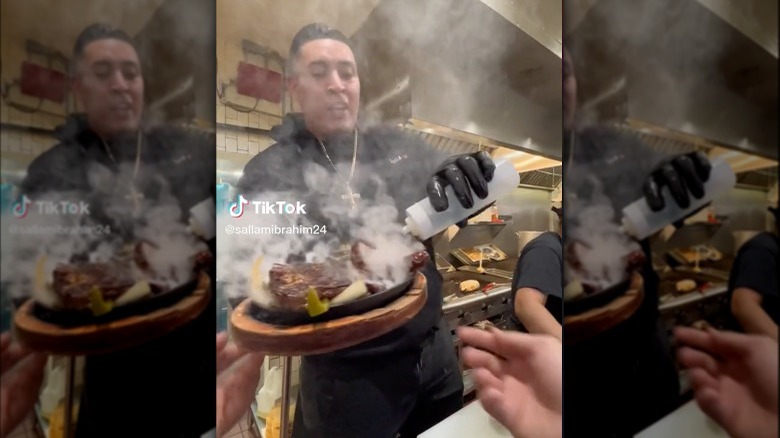The Fajita Sizzle Is Basically A Scam
The best part of ordering fajitas at a restaurant isn't whether they come with someone's preferred corn or flour tortillas or sound like a more nutritious option than smothered burritos and refried beans. It's that they come with a show. We've all been there – enjoying an appetizer at a Mexican or Tex-Mex restaurant when suddenly your server whizzes by with a smoking, sizzling plate of fajitas. It's a head-turning, show-stopping spectacle that also seemingly serves as an indicator that your food was served fresh off the grill. But apparently, the iconic fajita sizzle isn't the result of smoking-hot meat.
According to a recent TikTok post shared by a restaurant employee, the familiar fajita sizzle is simply the result of water making contact with the hot cast-iron plate the fajitas are served on. When the water meets the plate, a rush of water vapor billows upwards creating that familiar stream of crackling smoke that's synonymous with restaurant fajitas.
@sallamibrahim24
Fajita fans rushed to the comment section under the TikTok video to leave their two cents on the subject. One person said "I didn't even think of this. I just assumed the food was hot as hell." Another person expressed gratitude quipping, "Fooled me for 34 years. Thank you."
The fajita sizzle is just water on the cast iron pan
You might feel bamboozled to discover that sizzling fajitas are just a kitchen trick. But chances are, if your fajitas are sizzling with so much intensity that a whole restaurant can see and hear it, they're being overcooked. So it's actually for the best that your meat isn't kicking up enough steam to fill a room.
When water makes contact with a surface at a high enough temperature, bubbles form and explode like tiny bombs. The crackling sizzle you hear when an order of steamy fajitas arrives at your table is just the sound of the bubbles detonating on your plate. When water is heated, its molecules start moving faster and faster. The foggy stream that pours out of sizzling fajitas occurs when some fast-moving molecules escape into the air and transform into water vapor.
Some restaurants like Ninfa's in Houston may use lime juice to create the fajita sizzle. So it's possible to get the theatrics and add an element of zesty citrus to the plate — fun and functional! If you want to try your hand at DIY sizzling fajitas, you can add water, lime juice, or alternatives like a drizzle of oil or other citrus fruits like lemon or grapefruit. The more you know!

